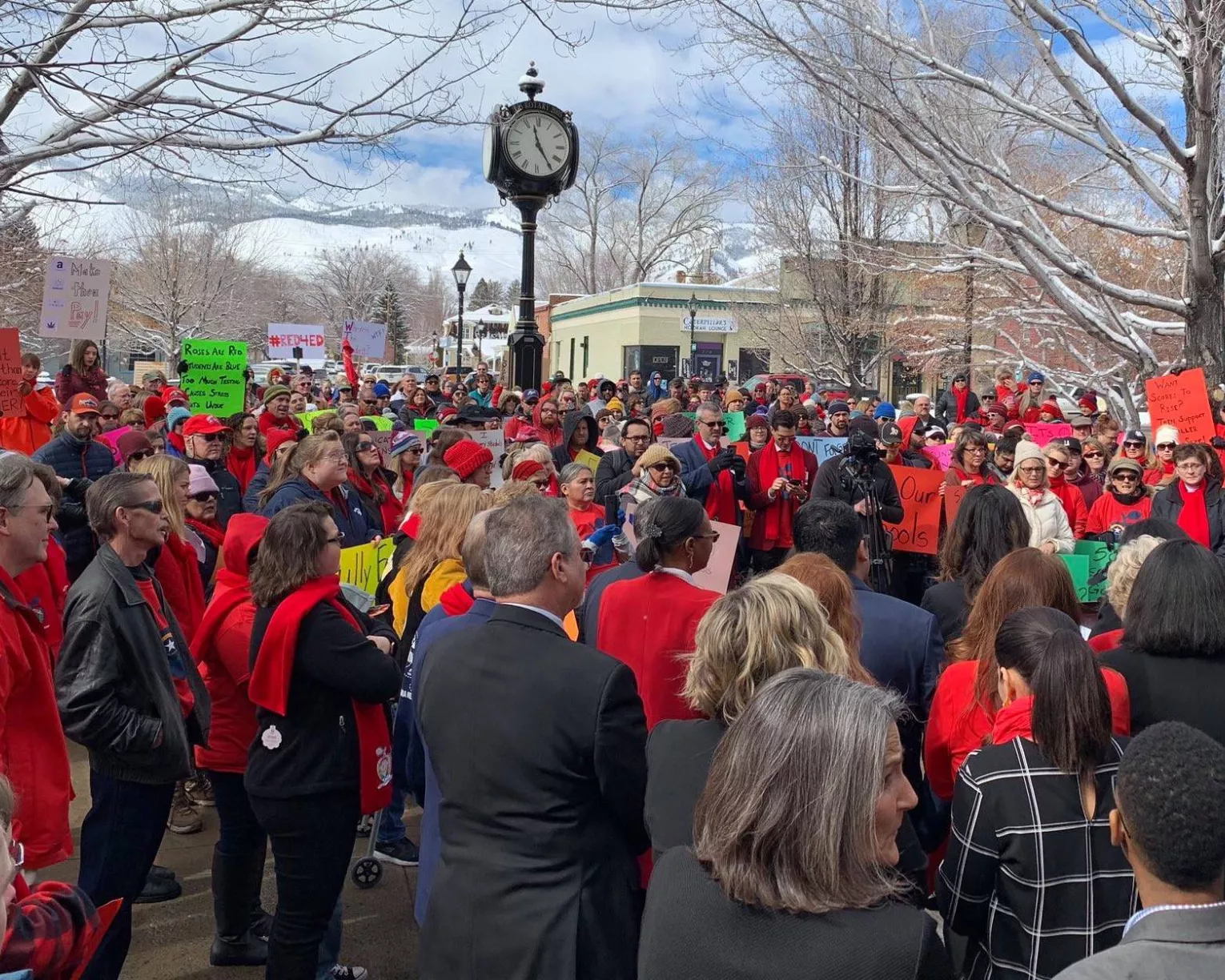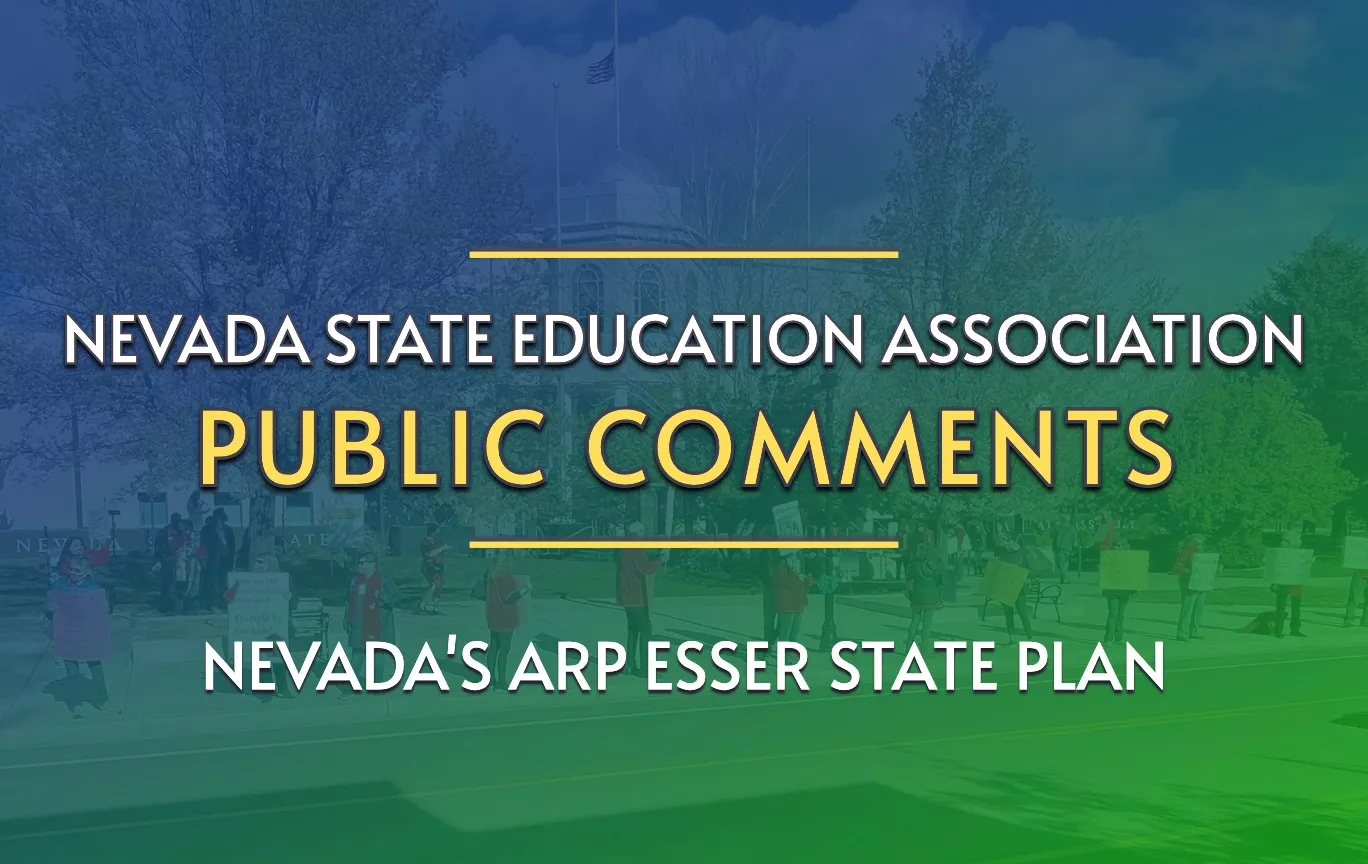NEA members wrote hundreds of thousands of messages and placed thousands of calls to their representatives advocating for Congress to pass this package containing the largest investments ever in education. NSEA is now taking this opportunity to submit public comment on Nevada’s ARP ESSER State Plan.
PROCESS CONCERNS
Before providing input on details of the state plan, we first want to take this opportunity to raise concerns about the stakeholder process in its development. The section “Modeling and Sharing Best Practices for Meaningful Stakeholder Engagement” begins on page 14 and outlines the stakeholder engagement process including a list of 36 stakeholder groups engaged to guide the development of the plan. However, NSEA was not included in that initial process, despite language in the ARP requiring SEA’s to engage with “educators and their unions” in the development of the plan. In addition to this, the Nevada Department of Education offers guidance to LEA’s in the development of their plans. While the requirement for LEA’s to engage with “educators and their unions” is mentioned, it does not engender confidence LEA processes are going to be any better than the state process. Immediately following the release of the draft plan, NSEA reached out to the State Superintendent of Public Instruction. We appreciate the quick scheduling of a feedback session for educators and their unions on the draft plan. However, it would have been better to have been included in the development of the draft plan, as called for in the ARP.
MEASURING ACADEMIC PERFORMANCE
NSEA is in general agreement with the top issues identified in Nevada’s draft state plan— supporting social, emotional and mental health, addressing interrupted learning, and recruiting, supporting, and retaining effective educators. However, we do have comments on several details of the plan. The section “Leveraging Data to Identify Groups of Students Most Adversely Impacted by COVID-19” begins on page 15. This section discusses measuring student academic performance using various standardized tests including the SBAC and student growth using a skip-year analysis based on the results of these assessments. NSEA continues to have concerns about reliance on standardized testing, and the toll of these tests on students and educators, especially during these pandemic years. The time and pressures associated with standardized testing work against two of the three top issues identified in the state plan—supporting social, emotional, and mental health and supporting and retaining effective educators. In internal surveys, NSEA has consistently found over-testing as a top concern of educators across the state. Meanwhile, we have seen poor data quality in testing results, given distance and hybrid school models, and we know standardized tests continue to reflect racial bias. Other indicators to measure interrupted learning, including attendance, credit sufficiency, graduation rates, teacher information, discipline data, school climate survey results, and financial information should be buttressed by feedback from classroom educators on student performance, who have a better appreciation for the impact of the pandemic on their students, particularly in the elementary grades.
COMPREHENSIVE NEEDS ASSESSMENT
The section “Maximizing Resources to Respond to the Needs of Students Most Adversely Impacted by COVID-19” is on page 18. This section calls for contracting with an education evaluation firm to conduct a statewide comprehensive needs assessment. Given process concerns outlined above in the development of the draft state plan, NSEA wants to ensure educators and their unions play a central role in the development of this needs assessment.
SAFELY REOPENING SCHOOLS AND SUSTAINING THEIR SAFE OPERATIONS
Table B1 on page 20 outlines Emergency Directives and guidance that have implications for school settings. Universal and correct wearing of masks for all adults and students over the age of 9 is mentioned. However, the document, when drafted, did not contemplate the severe pushback school districts, school boards, and educators would receive over this issue. With the emergence of the Delta variant and rising COVID cases in Nevada, including younger people, and vaccines not yet being available to children under 12, this has become an increasingly charged issue heading into the start of the school year. NSEA appreciates Emergency Directive 048 related to mask requirements in K12 education settings issued by Governor Sisolak last week. However, given the impact of the Delta variant across the state of Nevada, we believe there should be additional guidance on this issue to all Nevada school districts.
Guidance Memorandum 21-02 from May 28, 2021 gives decision-making authority on capacity limits and social distancing protocols to LEA’s but also sets the expectation that schools will all be open with the capacity to offer in-person learning to all students. This guidance from late May does not reflect the developments in COVID-19 in Nevada with the Delta variant and does not take into account how politically- charged these issues have become at school board meetings. With the rise of the Delta variant and the return to school, Nevada should be prepared to expedite vaccinations of students under 12 as soon as possible. Vaccination requirements for students and educators should be considered and school districts should be encouraged to collaborate and bargain with educator unions, so all educators and students can be safe and appropriate accommodations made. Ultimately the success of school reopenings will largely be dependent on the state’s success in getting the Delta variant under control.
The TIES program is presented on page 21, as a mitigation strategy for diagnostic and screening testing. This program is an example of a state initiative that was developed without input from educators across the state or their state union. $6.2 million from the CARES Act was spent, yet the program was never embraced by those it was supposed to serve, resulting in too few educators tested. The TIES program was a failure and points to the need for true engagement with educators across the state. Meanwhile, in other parts of the state like Washoe County, the district was able to offer testing through their existing health option, which was familiar to educators there, and worked reasonably well.
EDUCATOR RECRUITMENT, SUPPORT, AND RETENTION
The issue of support for educators and educator recruitment and retention is identified as a priority in the state plan. We agree with this and would point out when educators and their unions are left out of processes that impact them, not only is their voice and perspective missing, it also negatively impacts morale, further harming retention efforts. NSEA generally agrees with the recommendations of the educator recruitment and retention task force and would emphasize workplace issues like class size and caseloads, evaluations, standardized test time, and valuing educator voice and agency in their work as major factors not adequately addressed in this plan.
LOCAL EDUCATION AGENCIES
Page 34 discusses distribution of ESSER I and ESSER II dollars to LEA’s. We have heard concern from various school districts about confusion and delays in accessing these funds, although it is difficult for us to discern exactly what the problems are and/or who is responsible. We do know decisions regarding a majority of ESSER dollars will be made at the LEA level.
NSEA is very concerned about guidance given to LEA’s on page 47 of the ARP ESSER Planning Guide for LEA’s related to budget reduction strategies, specifically the design consideration of “delaying pay raises or furloughing non-working staff.” This consideration runs counter to the state’s overall goal of recruiting and retaining educators, as it is conventionally known that educator pay is a key factor in educator recruitment and retention.
SOCIAL AND RACIAL EQUITY
Page 41 discusses a training provided by the National Equity Project to equip educators to respond to systemic racism and inequities, etc. NSEA has been a leading voice for increased social and racial equity in education. At the same time we have been seeing an unprecedented attack in recent months on educators and schools related to dealing with system racism (or critical race theory). We don’t feel school districts or school boards have been adequately supported in this important equity work given the virulent attacks they have faced and would like to see more in this plan to support this critical work.
As always, NSEA is ready to partner with the Nevada Department of Education on the important work of finalizing the state ARP ESSER Plan and on its implementation, so we can safely reopen schools and sustain their safe operation, while supporting social, emotional and mental health of students and educators, addressing interrupted student learning, and recruit, support, and retain effective educators.
What's On Your Mind?

